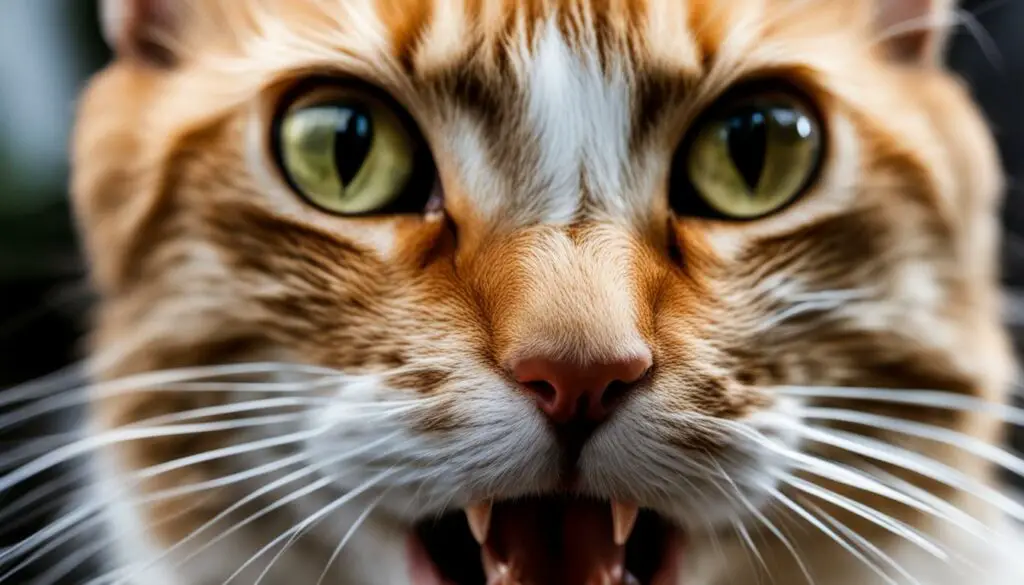Welcome to my blog post where I will explore the reasons behind why your male cat keeps meowing and biting, and provide you with some effective solutions. As a pet owner, it can be concerning and frustrating to witness these behaviors, but understanding the underlying factors and implementing the right strategies can help address the issue and improve your relationship with your furry friend. Let’s delve into the world of feline behavior and communication to find the answers you’re looking for.
Male cats often use meowing and biting as forms of communication, but the motivations behind these behaviors can vary. It can be a way for them to seek attention, express their needs or emotions, playfulness, or even aggression. By understanding the specific context and cues, we can better interpret their behavior and find appropriate solutions.
Training and socialization are essential tools in modifying your cat’s behavior. Positive reinforcement, along with gentle discipline, can teach your cat appropriate ways to communicate and interact. Early socialization is particularly important for kittens to ensure they grow into well-behaved adults. Additionally, recognizing the importance of the human-animal bond and building a positive relationship with your cat can help reduce meowing and biting behaviors.
It’s also crucial to consider medical and environmental factors that may influence your cat’s behavior. Regular veterinary check-ups can rule out any underlying health issues, while modifying their environment to reduce stressors and provide stimulation can have a positive impact. By addressing these factors, you can create a harmonious living space for both you and your cat.
By delving into the world of your male cat’s behavior and communication, we can unravel the reasons behind their meowing and biting. With the right understanding, training techniques, and veterinary guidance when needed, you can provide your cat with the environment and support they need to thrive.
Key Takeaways:
- Meowing and biting are forms of communication for male cats.
- Understanding the underlying motivations behind these behaviors is crucial.
- Training, socialization, and building a strong bond with your cat can help reduce meowing and biting.
- Regular veterinary check-ups and addressing environmental factors are vital in managing their behavior.
- Seeking professional help may be necessary for complex behavioral issues.
Why Do Cats Meow and Bite?
Cats are known for their unique behaviors, and meowing and biting are two common actions that can puzzle cat owners. Understanding the reasons behind these behaviors is essential for building a strong bond with your furry companion and addressing any underlying issues that may be causing them. Let’s explore why cats meow and bite and what they may be trying to communicate.
The Purpose of Meowing:
Meowing is a vocalization that cats use to communicate with humans. It can serve various purposes, such as expressing their needs or desires. For example, a cat may meow to seek attention, request food or water, or indicate that they want to play or go outside. Meowing can also be a way for cats to greet their owners or communicate when they are feeling lonely or anxious. By paying attention to the context and tone of your cat’s meowing, you can gain insights into their current emotional state and address their needs accordingly.
The Motivations Behind Biting:
Biting in cats can have multiple motivations. While some cats may bite playfully during interactive sessions, others may exhibit aggressive behaviors, especially when they feel threatened, scared, or provoked. Biting can also be a way for cats to express discomfort or pain. It’s crucial to observe your cat’s body language and overall interaction patterns to understand the specific triggers behind their biting behavior. This awareness will help you create a safe and supportive environment for your cat and prevent any potential harm to yourself or others.
Addressing Meowing and Biting:
If your cat’s meowing or biting behavior becomes excessive or problematic, it’s important to address it promptly. Start by ensuring that your cat’s basic needs, such as food, water, and a clean litter box, are met. Provide plenty of mental and physical stimulation through interactive play sessions and environmental enrichment. If the behavior persists, consider consulting with a veterinarian or a certified animal behaviorist who can offer tailored advice and guidance to help modify your cat’s behavior effectively.
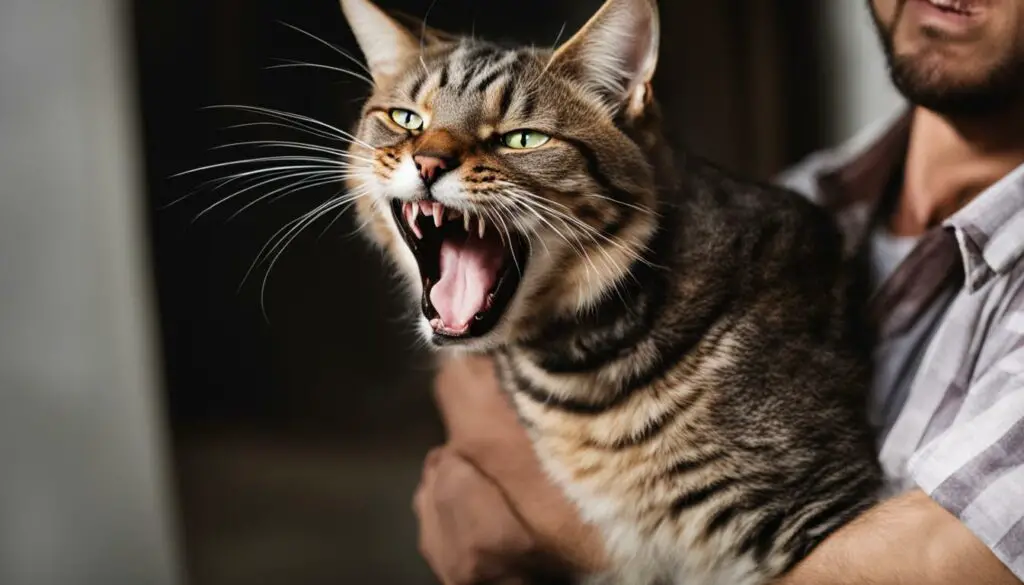
Remember, every cat is unique, and understanding their individual needs and behaviors is key to maintaining a harmonious relationship. By being attentive to their communication cues and providing a loving and supportive environment, you can help your cat feel safe, secure, and happy.
Reasons for Meowing and Biting in Male Cats
Male cats may exhibit meowing and biting behavior for various reasons. Understanding these underlying factors can help pet owners address and modify their cat’s behavior effectively. Here are some common reasons why male cats engage in meowing and biting:
- Attention-seeking: Male cats may meow and bite as a way to seek attention from their owners. They may want to play, be petted, or simply engage in interaction.
- Territorial behavior: Meowing and biting can be a territorial display in male cats. They may use aggression to mark their territory or assert dominance.
- Playfulness: Some male cats may meow and bite during play sessions. It’s important to establish appropriate boundaries and redirect their play behavior to prevent excessive biting.
- Stress and anxiety: Male cats may exhibit meowing and biting as a response to stressful situations or anxiety. Identifying and addressing the source of stress can help alleviate these behaviors.
- Pain or discomfort: Cats may vocalize and bite when they are experiencing pain, discomfort, or irritation. It could be due to an underlying medical condition or injury.
- Fear and provocation: Meowing and biting can also be a defensive response in male cats when they feel threatened or provoked. They may use aggression as a means to protect themselves.
Understanding the specific triggers and emotions behind a male cat’s meowing and biting behavior is essential in developing an appropriate plan to modify their behavior. It’s important to observe their body language and cues to better comprehend their needs and address any underlying issues that may be contributing to these behaviors.
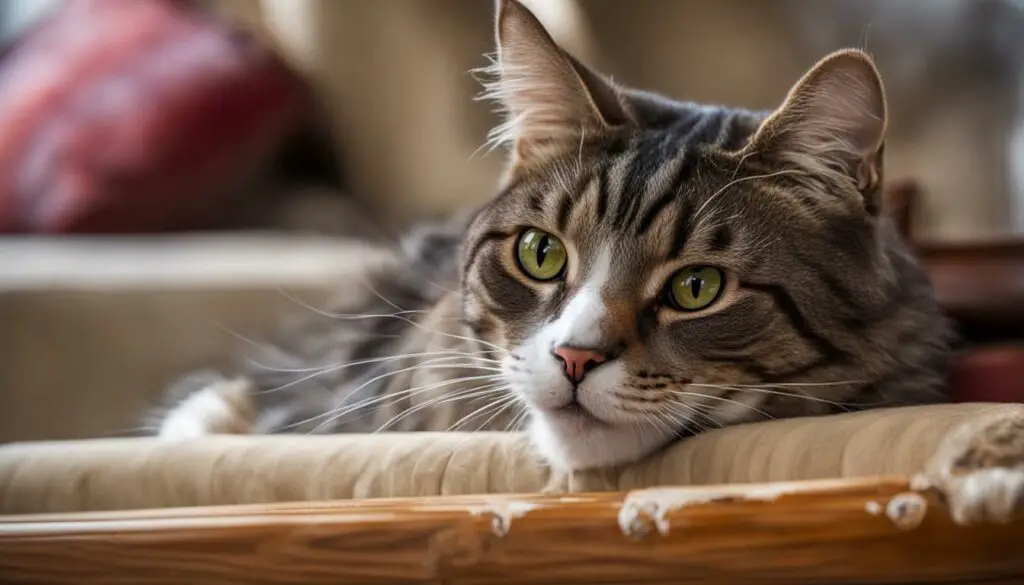
The Importance of Socialization
Socialization plays a critical role in managing meowing and biting behavior in male cats. By exposing them to various people, animals, and environments from a young age, cats can develop the necessary skills to interact appropriately and express themselves without resorting to meowing and biting. Positive interactions, rewards, and gentle discipline can help reinforce desired behaviors and discourage unwanted ones. Additionally, providing an enriched environment with plenty of toys, scratching posts, and hiding spots can help alleviate boredom and promote a sense of security.
Seeking Professional Guidance
If a male cat’s meowing and biting behavior persists or becomes problematic, seeking professional guidance from a veterinarian or certified animal behaviorist is recommended. These experts can conduct a thorough behavior assessment, identify any underlying medical issues, and provide tailored interventions to modify the cat’s behavior effectively. They can also offer expert advice and guidance on training techniques, environmental modifications, and stress reduction strategies that can help address the issue.
Understanding Vocal Cues and Body Language
When it comes to deciphering our male cat’s behavior, vocal cues and body language can provide valuable insights into their emotions and needs. By paying close attention to how our feline companions communicate through their meows, purrs, and body movements, we can develop a deeper understanding of their unique personalities.
Vocal cues are an essential aspect of cat communication. Each type of meow carries a specific message, whether it’s a greeting, a request for attention, or a sign of distress. A short, high-pitched meow, for example, often indicates a desire for interaction, while a prolonged, low-pitched meow might suggest a need for food or access to the outdoors.
Equally important is observing our cat’s body language. A relaxed and contented cat typically has a loose tail that gently sways from side to side, ears that sit comfortably forward, and eyes that appear soft and half-closed. Conversely, a cat that feels threatened or anxious may flatten its ears against its head, arch its back, or puff out its fur as a defensive display. Understanding these visual cues can help us respond appropriately and provide the support and reassurance our male cat needs.
Common Vocal Cues and Body Language
| Vocal Cues | Body Language |
|---|---|
| “Meow” (short, high-pitched) | Relaxed body posture |
| “Meow” (prolonged, low-pitched) | Engaging eye contact |
| Purring | Slow blinking |
| Hissing or growling | Flattened ears |
| Chirping or trilling | Raised tail |
Developing empathy and a keen understanding of our male cat’s vocal cues and body language can strengthen the bond between human and feline. By fostering this connection, we can create a harmonious environment where our cat feels safe, understood, and loved.
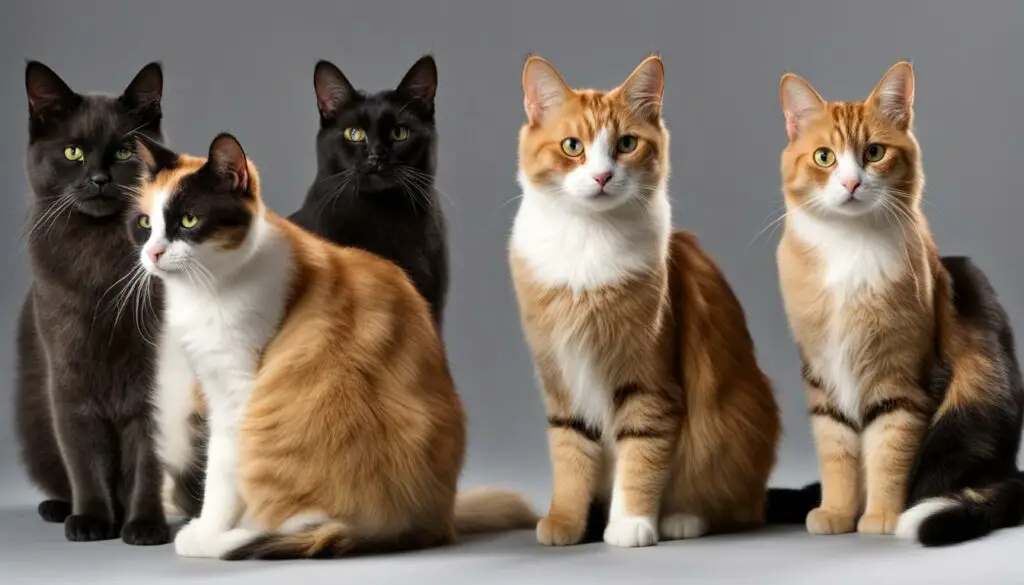
Types of Aggressive Behavior in Male Cats
Aggressive behavior in male cats can manifest in different forms, each with its own underlying causes and triggers. Understanding these types of aggression can help pet owners better address and manage their cat’s behavior. Here are the main types of aggressive behavior seen in male cats:
1. Redirected Aggression
Redirected aggression occurs when a cat redirects its aggression towards a different target, often due to frustration or fear. For example, a cat might become agitated by seeing another cat outside the window and then turn and attack its owner or a fellow pet. Recognizing the signs and triggers of redirected aggression can help prevent these outbursts and provide appropriate outlets for the cat’s frustration.
2. Petting-Induced Aggression
Some cats may exhibit aggression when being petted or stroked for a prolonged period. This can happen when a cat becomes overstimulated or uncomfortable, leading to biting or scratching. Understanding a cat’s body language and recognizing signs of overstimulation, such as twitching or lashing tail, can help prevent petting-induced aggression. It’s essential to respect a cat’s boundaries and provide them with breaks during petting sessions.
3. Play Aggression
Play aggression is commonly seen in younger cats or kittens engaging in rough play. While it may seem harmless at first, play aggression can escalate and lead to injuries. Providing appropriate outlets for play, such as interactive toys and playtime with other cats, can help redirect this energy and prevent aggressive behavior towards humans.
4. Fear Aggression
Fear aggression is a defensive response to a perceived threat. Cats experiencing fear aggression may hiss, growl, or lunge when they feel cornered or scared. This type of aggression can be triggered by various situations, such as encounters with unfamiliar people or animals. Creating a safe and secure environment, along with gradual exposure to new stimuli, can help reduce fear-based aggression in male cats.
5. Intercat Aggression
Intercat aggression refers to aggression between cats. This can occur when introducing a new cat to the household or when territorial disputes arise. Understanding the dynamics between the cats, providing separate resources, and implementing gradual introductions can help reduce intercat aggression. In some cases, professional intervention may be necessary to address this type of aggression.
While these are the main types of aggressive behavior in male cats, it’s important to note that individual cats may exhibit a combination of these behaviors or display unique variations. Consulting with a veterinarian or animal behaviorist can provide tailored advice and strategies for managing and modifying aggressive behavior in male cats.
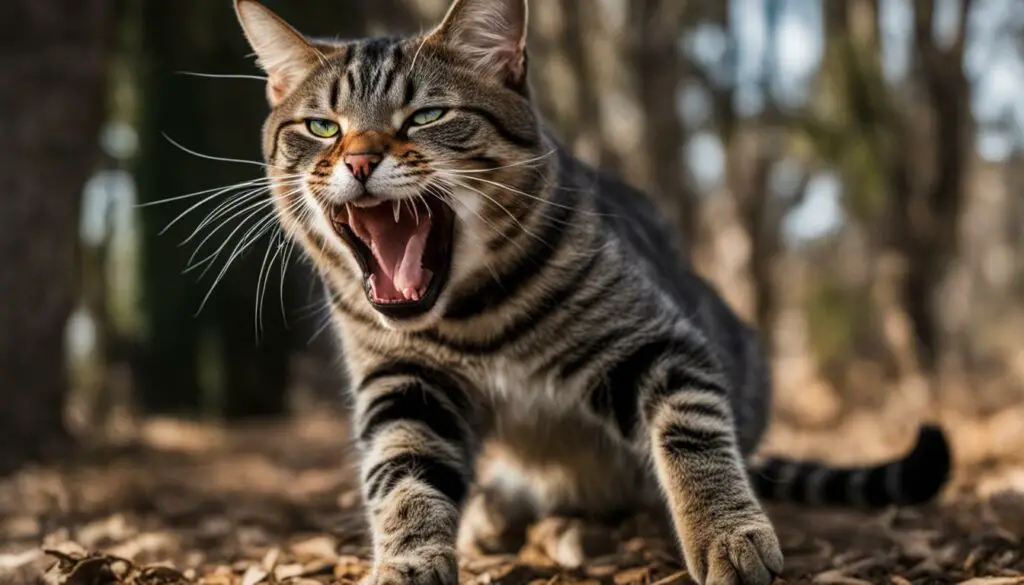
Factors Influencing Male Cat Behavior
When it comes to understanding and addressing meowing and biting behavior in male cats, it is important to consider various factors that can influence their behavior. These factors include behavioral issues, environmental factors, medical issues, neutering, stress, anxiety, discomfort, and fear.
Behavioral issues can arise due to changes in the cat’s environment or a lack of stimulation. Cats are sensitive creatures, and any alterations to their surroundings can impact their behavior. Providing a stimulating and enriching environment with toys, scratching posts, and hiding spots can help alleviate behavioral issues.
In some cases, medical issues can also contribute to behavioral changes in male cats. Pain, discomfort, or other underlying health conditions can lead to meowing and biting behavior. Regular veterinary check-ups are crucial for identifying and addressing any medical concerns that may be affecting the cat’s behavior.
Neutering can play a significant role in reducing aggressive behaviors in male cats. It helps to curb hormonal influences and diminishes territorial instincts, which can contribute to excessive meowing and biting. If behavioral issues persist after neutering, seeking professional help from a behaviorist or training specialist is recommended.
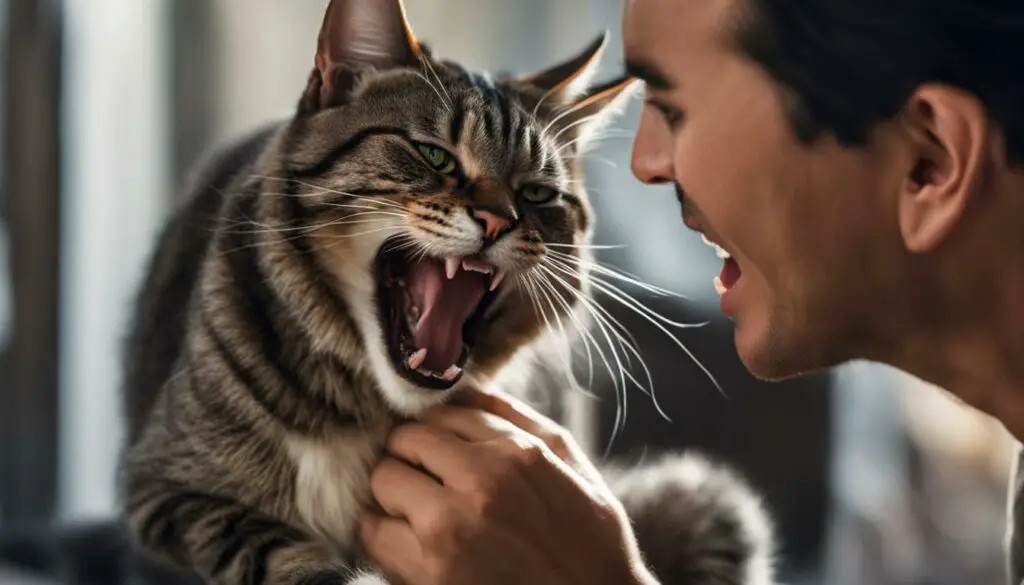
Table: Factors Influencing Male Cat Behavior
| Factors | Impact on Behavior |
|---|---|
| Behavioral issues | Changes in environment, lack of stimulation |
| Medical issues | Pain, discomfort, underlying health conditions |
| Neutering | Reduces aggressive behaviors, curbs hormonal influences |
| Stress, anxiety, discomfort, and fear | Can contribute to meowing and biting behavior |
Addressing these factors through environmental modifications, veterinary care, and behavioral interventions can help create a harmonious and balanced living environment for male cats. It is important to approach these issues with empathy, patience, and understanding to ensure the well-being and happiness of our feline companions.
Training and Socialization Techniques
Training and socialization are essential for addressing and modifying a male cat’s meowing and biting behavior. By implementing effective techniques, you can encourage positive behavior and reduce unwanted aggression. Here are some key strategies:
Positive Reinforcement
Positive reinforcement is a highly effective training method for cats. Reward your cat with treats, praise, or playtime whenever they exhibit desirable behaviors, such as calmness or appropriate play. This helps reinforce positive associations and encourages them to repeat those behaviors in the future.
Redirection
If your cat engages in biting or aggressive behaviors, redirect their attention to an appropriate toy or scratching post. This helps to redirect their energy and focus onto more acceptable outlets for their natural instincts.
Gentle Discipline
When your cat exhibits unwanted behaviors, it’s important to establish boundaries and gently discourage those behaviors. Avoid physical punishment, as it can lead to fear or aggression. Instead, use a firm, yet gentle, tone of voice and redirect their attention to more appropriate activities.
Early Socialization
Early socialization is particularly crucial for kittens. Gradually introduce them to a variety of people, animals, and environments in a positive and controlled manner. This helps them become accustomed to different stimuli and reduces the likelihood of fear or aggression later in life.
| Training Technique | Description |
|---|---|
| Positive Reinforcement | Rewarding desired behaviors with treats, praise, or playtime to encourage repetition. |
| Redirection | Directing your cat’s attention to appropriate toys or scratching posts to prevent unwanted behaviors. |
| Gentle Discipline | Setting boundaries and gently discouraging unwanted behaviors using a firm, yet gentle, tone of voice. |
| Early Socialization | Gradually introducing kittens to different people, animals, and environments to promote adaptability. |
By utilizing these training and socialization techniques, you can help your male cat develop appropriate behaviors and reduce meowing and biting. Remember to be patient, consistent, and provide a safe and enriching environment for your feline companion.

The Importance of Veterinary Check-ups
Regular veterinary check-ups are crucial for the overall health and well-being of your male cat. These check-ups allow for a thorough medical examination, which can help identify any underlying medical issues that may be contributing to your cat’s meowing and biting behavior. By addressing these medical concerns, you can effectively manage and modify your cat’s behavior.
Additionally, veterinary check-ups provide an opportunity for a behavioral assessment by a veterinarian or a certified animal behaviorist. This assessment can provide valuable insights into the reasons behind your cat’s behavior and guide the development of a comprehensive treatment plan. Seeking professional advice can be particularly beneficial when dealing with complex behavioral issues or when other interventions have not yielded significant improvements.
By prioritizing regular veterinary check-ups for your male cat, you are taking an important step in ensuring his overall well-being and addressing any potential medical or behavioral issues that may be causing his meowing and biting behavior.
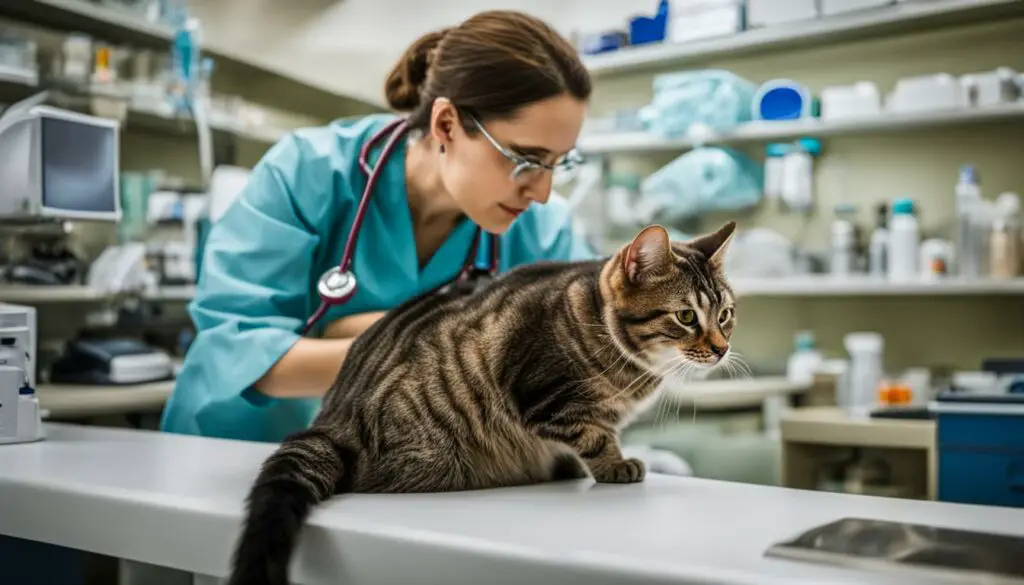
The Importance of Veterinary Check-ups
Regular veterinary check-ups are crucial for the overall health and well-being of your male cat. These check-ups allow for a thorough medical examination, which can help identify any underlying medical issues that may be contributing to your cat’s meowing and biting behavior. By addressing these medical concerns, you can effectively manage and modify your cat’s behavior.
Additionally, veterinary check-ups provide an opportunity for a behavioral assessment by a veterinarian or a certified animal behaviorist. This assessment can provide valuable insights into the reasons behind your cat’s behavior and guide the development of a comprehensive treatment plan. Seeking professional advice can be particularly beneficial when dealing with complex behavioral issues or when other interventions have not yielded significant improvements.
By prioritizing regular veterinary check-ups for your male cat, you are taking an important step in ensuring his overall well-being and addressing any potential medical or behavioral issues that may be causing his meowing and biting behavior.
| Benefits of Veterinary Check-ups: |
|---|
| Early detection and treatment of medical issues |
| Behavioral assessment by experts |
| Development of a comprehensive treatment plan |
| Improved well-being and quality of life |
Calming Techniques
When it comes to managing the meowing and biting behavior of your male cat, calming techniques can be highly effective in promoting a sense of relaxation and reducing stress and anxiety. Creating a calm and enriched environment is key to helping your cat feel safe and secure in their surroundings.
One technique you can try is providing hiding spots throughout your home. Cats often seek out enclosed spaces when they are feeling stressed or overwhelmed. These hiding spots can be as simple as cardboard boxes or designated areas with cozy blankets.
Interactive toys and scratching posts can also be beneficial in promoting physical and mental stimulation for your cat. Play sessions not only help to redirect their energy but also provide a positive outlet for their natural instincts. Additionally, providing a variety of toys that simulate hunting behaviors can help keep your cat engaged and reduce any pent-up frustration that may lead to unwanted biting behavior.
| Calming Techniques | Benefits |
|---|---|
| Creating hiding spots | Reduces stress and provides a safe space |
| Using interactive toys | Provides mental and physical stimulation |
| Utilizing scratching posts | Redirects scratching behavior and promotes exercise |

In addition to environmental enrichments, there are other calming techniques that can help manage your cat’s behavior. Pheromone therapy, such as the use of synthetic pheromone diffusers or sprays, can create a calming effect in cats by mimicking natural pheromones that promote relaxation. Music therapy is another option, as certain types of classical or calming music have been found to have a soothing effect on cats.
If your cat’s anxiety is severe, you may consider discussing calming supplements with your veterinarian. There are various natural supplements available that can help reduce stress and anxiety in cats. However, it is important to consult with your vet before introducing any new supplements to your cat’s routine.
Remember, each cat is unique, so it may take some trial and error to find the most effective calming techniques for your male cat. Patience and consistency are key when implementing these techniques, and always monitor your cat’s response to determine what works best for them.
Seeking Professional Help
While there are many strategies and techniques that pet owners can implement to address meowing and biting behavior in male cats, there may be situations where seeking professional help becomes necessary. Consulting a behaviorist or working with a training specialist can provide invaluable expertise and guidance in managing and modifying a cat’s behavior effectively.
Behaviorists are professionals who specialize in animal behavior and can offer tailored interventions based on the specific needs and context of your cat’s behavior. They have a deep understanding of feline behavior and can provide expert advice on addressing complex behavioral issues. A behaviorist will conduct a thorough assessment of your cat’s behavior, taking into account various factors such as the cat’s environment, experiences, and triggers.
Working with a training specialist can also be beneficial, especially if the meowing and biting behavior is related to training or socialization. These professionals are skilled in designing and implementing training programs to address specific behavioral issues. They can guide you in using positive reinforcement techniques and help you establish effective communication and boundaries with your cat.
Remember, seeking professional help does not mean you have failed as a pet owner. It simply means that you are taking proactive steps to provide your cat with the best care and support possible. By collaborating with experts, you can gain valuable insights into your cat’s behavior and receive personalized strategies to address the issue at hand.
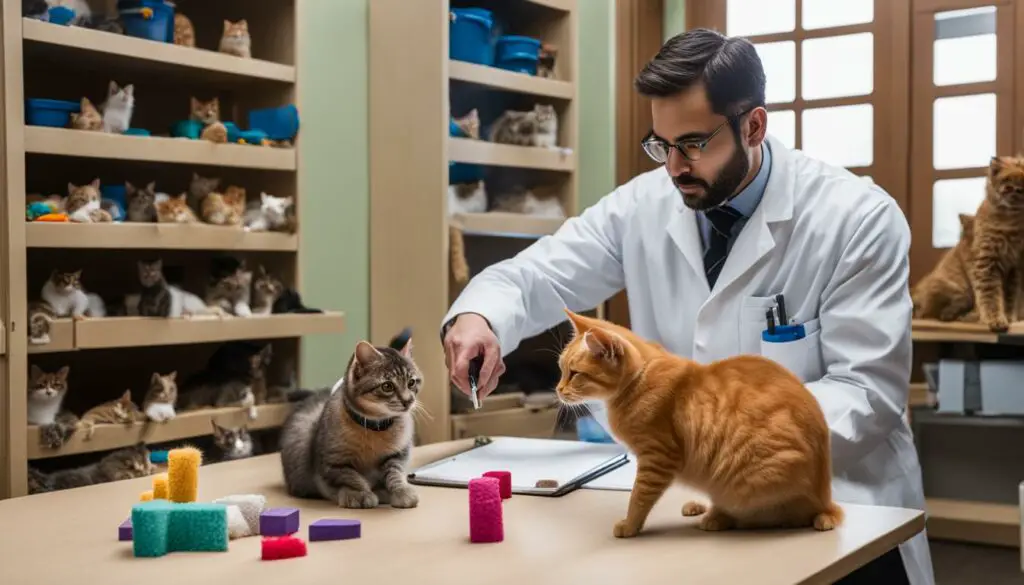
The Importance of the Human-Animal Bond
The relationship between humans and their pets, including male cats, goes beyond mere companionship. It is a unique bond that is built on understanding, empathy, and trust. When it comes to addressing meowing and biting behavior in male cats, cultivating a strong human-animal bond is crucial. This bond forms the foundation for effective communication and behavioral modification.
Understanding your male cat’s needs and emotions is essential in creating a positive relationship. Cats have their own ways of expressing themselves, through vocalizations, body language, and behaviors. By paying attention to these signals and cues, you can better understand what your cat is trying to communicate. This understanding allows you to respond appropriately and meet their needs, reducing the likelihood of meowing and biting behavior.
“The language of cats is subtle and nuanced. The more time we spend observing and interacting with them, the better equipped we become at deciphering their messages,” says Dr. Emily Johnson, a feline behavior specialist.
Empathy plays a significant role in building a strong bond with your male cat. Empathizing with their emotions and experiences helps you connect on a deeper level. It allows you to provide comfort and reassurance when they are feeling stressed or anxious. By creating a safe and nurturing environment, you can foster a sense of security for your cat, thereby reducing the likelihood of meowing and biting behavior.
A positive relationship between a human and their male cat is a two-way street. It involves spending quality time together, engaging in interactive play, and providing affection and attention. By actively participating in your cat’s life, you strengthen the bond between you, creating a harmonious and balanced living environment.

Benefits of a Strong Human-Animal Bond:
- Increased trust and communication
- Reduced stress and anxiety
- Improved overall well-being for both cat and owner
- Enhanced understanding of your cat’s needs and behaviors
- Stronger emotional connection and companionship
Tips for Strengthening the Human-Animal Bond:
- Set aside dedicated time each day for bonding activities, such as play sessions or grooming.
- Use positive reinforcement techniques, such as treats or praise, to reward desired behaviors.
- Practice active listening and observation to better understand your cat’s communication cues.
- Create a safe and enriched environment with toys, scratching posts, and comfortable resting areas.
- Seek professional guidance or attend training classes to further enhance your bond with your male cat.
By prioritizing the human-animal bond and fostering understanding, empathy, and a positive relationship, you can create a harmonious environment for your male cat. This, in turn, will help reduce meowing and biting behavior, allowing both you and your feline companion to enjoy a peaceful and fulfilling life together.
Addressing Medical Concerns and Environmental Factors
When dealing with meowing and biting behavior in male cats, it is important to consider both medical concerns and environmental factors. A thorough veterinary examination is crucial to rule out any underlying medical issues that may be causing or exacerbating the behavior. Medical issues such as pain, discomfort, or illness can play a significant role in a cat’s behavior, and addressing these issues is essential for effective behavior modification.
Furthermore, evaluating and modifying the cat’s environment can also have a positive impact on behavior. Environmental factors, such as a change in surroundings or lack of stimulation, can contribute to stress and anxiety in cats, leading to unwanted behaviors like excessive meowing or biting. Providing an enriching environment with plenty of hiding spots, scratching posts, and interactive toys can help alleviate stress and provide mental stimulation.
A behavior assessment, conducted by a veterinarian or a certified animal behaviorist, can provide valuable insight into the reasons behind a cat’s meowing and biting behavior. This assessment can help identify specific triggers and develop a comprehensive treatment plan tailored to the individual cat’s needs. Making changes to the cat’s environment and addressing any medical concerns are key steps in managing and modifying the behavior.
| Medical Concerns | Environmental Factors |
|---|---|
|
|
In conclusion, addressing meowing and biting behavior in male cats requires a holistic approach that takes into account both medical concerns and environmental factors. A thorough veterinary examination, along with a behavior assessment, can provide valuable insights into the underlying causes of the behavior. By addressing any medical issues and making appropriate changes to the cat’s environment, pet owners can create a harmonious and balanced living environment that promotes positive behavior and enhances the well-being of their feline companions.
Conclusion
In conclusion, understanding the reasons behind a male cat’s meowing and biting behavior is essential for finding effective solutions. Cats use these behaviors as forms of communication, and it is important to interpret their cues and signals correctly.
By implementing training and socialization techniques, pet owners can address undesirable behaviors and promote positive interactions. Rewarding desired behaviors and redirecting unwanted ones are effective methods for modifying a cat’s behavior.
Regular veterinary check-ups play a vital role in maintaining a cat’s overall health and well-being. A thorough examination can help identify any underlying medical issues that may contribute to behavioral changes.
Building a strong human-animal bond, fostering understanding and empathy, and providing a safe and enriching environment are key components of addressing meowing and biting behavior in male cats. By considering both medical concerns and environmental factors, pet owners can create a harmonious and balanced living environment for their feline companions.
FAQ
Why does my male cat keep meowing and biting me?
Cats meow and bite for various reasons, including communication, playfulness, fear, or aggression. Understanding the underlying motivations and implementing appropriate training and socialization techniques can help address these behaviors.
How do cats communicate through meowing and biting?
Cats meow to express their wants and needs, while biting can have different motivations such as playfulness, aggression, fear, or an attempt to communicate a message.
What factors influence a male cat’s meowing and biting behavior?
Male cats may engage in meowing and biting behavior due to attention-seeking, territoriality, playfulness, dominance, stress, anxiety, discomfort, fear, pain, irritation, annoyance, or provocation.
How can I understand my cat’s vocal cues and body language?
Paying attention to vocalizations, tail movements, ear positions, and overall body language can provide insights into your cat’s emotions and needs.
What are the different types of aggressive behavior in male cats?
Male cats can exhibit redirected aggression, petting-induced aggression, play aggression, fear aggression, or intercat aggression.
What factors can influence a male cat’s behavior?
Behavioral issues in male cats can stem from environmental factors, medical issues, stress, anxiety, fear, discomfort, or the lack of neutering.
How can I train and socialize my male cat to address meowing and biting behavior?
Positive reinforcement techniques, redirection, discipline, and early socialization can help modify a cat’s behavior and promote appropriate interaction.
Why is regular veterinary check-up important for my male cat’s behavior?
Veterinary check-ups can identify any underlying medical issues that may contribute to behavioral changes and provide insights through a behavioral assessment.
What calming techniques can I use to manage my male cat’s meowing and biting behavior?
Creating a calm environment, engaging in regular play sessions, and using techniques like pheromone therapy or calming supplements can help calm a stressed or anxious cat.
When should I seek professional help for my male cat’s meowing and biting behavior?
If the behavior persists or becomes more complex, consulting a professional behaviorist or training specialist can provide tailored interventions and expert advice.
How can I build a strong human-animal bond with my male cat to address behavioral issues?
Spending quality time together, engaging in interactive play, and providing affection and attention can strengthen the bond, foster understanding, and reduce meowing and biting behaviors.
How can I address both medical concerns and environmental factors to help my male cat’s behavior?
A thorough veterinary examination can rule out any underlying medical issues, while evaluating and modifying the cat’s environment can reduce stressors and stimulation.
Source Links
- https://thecatsite.com/threads/male-cat-biting-and-dragging-me.428249/
- https://www.pumpkin.care/blog/why-does-my-cat/
- https://www.thesprucepets.com/stop-cat-bites-553893

